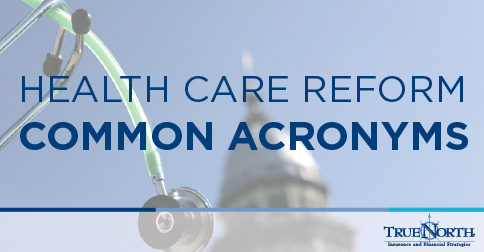Health Care Reform: Common Acronyms

There are a growing number of acronyms used in health care reform-related materials today. Here is a list of common acronyms and a definition for each:
ACA:
The Affordable Care Act. Used to refer to the final, amended version of the health care reform legislation.
CDC:
The Centers for Disease Control and Prevention.
CHIP:
The Children's Health Insurance Program. Program that provides health insurance to low-income children, and in some states, pregnant women who do not qualify for Medicaid but cannot afford to purchase private health insurance.
DOL:
United States Department of Labor.
EBSA:
Employee Benefits Security Administration. A division of the DOL responsible for compliance assistance regarding benefit plans.
EPO Plan:
An exclusive provider organization plan. A managed care plan that only covers services in the plan's network of doctors, specialists or hospitals (except in an emergency).
ERRP:
The Early Retiree Reinsurance Program. A temporary program created under health care reform to provide coverage to early retirees.
FPL:
Federal poverty level. A measure of income level issued annually by HHS and used to determine eligibility for certain programs and benefits.
FLSA:
The Federal Fair Labor Standards Act. Amended by PPACA to incorporate health care reform-specific provisions.
FSA:
Flexible spending account. Read our blog article on FSA eligible expenses.
HCERA:
The Health Care and Education Reconciliation Act of 2010. Enacted on March 30, 2010, to amend and supplement PPACA.
HCR:
Health care reform.
HDHP:
High deductible health plan.
HHS:
United States Department of Health and Human Services.
HMO:
Health maintenance organization. A type of health insurance plan that typically limits coverage to care from medical providers who work for or contract with the HMO.
HRA:
Health reimbursement arrangement or account.
HSA:
Health savings account.
IRO:
An independent review organization. An organization that performs independent external reviews of adverse benefit determinations.
MLR:
Medical loss ratio. Refers to the claims costs and amounts expended on health care quality improvement as a percent of total premiums. This ratio excludes taxes, fees, risk adjustments, risk corridors and reinsurance.
NAIC:
The National Association of Insurance Commissioners.
OCIIO:
The Office of Consumer Information and Insurance Oversight. A division of HHS responsible for implementing many of the health care reform provisions.
OOP:
Out-of-pocket limit. The maximum amount you have to pay for covered services in a plan year.
PCE:
Pre-existing condition exclusion. A plan provision imposing an exclusion of benefits due to a pre-existing condition.
PCIP:
The Pre-existing Condition Insurance Plan. A temporary high-risk insurance pool that provided coverage to eligible individuals until 2014.
POS Plan:
Point-of-service plan. A type of plan in which you pay less if you go to doctors, hospitals and other health care providers that belong to the plan's network. POS plans require a referral from your primary care doctor to see a specialist.
PPACA:
The Patient Protection and Affordable Care Act. Enacted on March 23, 2010, as the primary health care reform law.
PPO:
Preferred provider organization. A type of health plan that contracts with medical providers (doctors, hospitals) to create a network of participating providers. You pay less when using providers in the plan's network, but can use providersoutside the network for an additional cost.
QHP:
Qualified health plan. A certified health plan that provides an essential health benefits package. Offered by a licensed health insurer.
SHOP Exchange:
The Small Business Health Options Program. A program that each health insurance exchange must create to assist eligible small employers when enrolling their employees in qualified health plans offered in the small-group market.
TrueNorth's Employee Benefits
TrueNorth offers businesses of every size comprehensive solutions to meet their business needs and those of their employees. If you are in need of business solutions or are looking to start a business of your own, please call TrueNorth. Our Employee Benefits division would be happy to assist you in providing for the well-being of both you and your staff. Call us today at 1-800-798-4080.